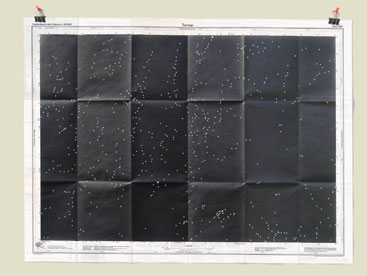
Born in 1959 in Larne, Northern Ireland (GB)
Lives and works in La Varenne (FR)

2006-2008
78 topographic maps
57 x 78 cm chacune
Year of Purchase: 2005
The Helvetic System is a set of topographical maps to a scale of 1:50000 which, when brought together, cover the whole of Switzerland. Each of them is completely painted over with black paint on which appear a myriad of white dots accurately marking out the mountain peaks and summits of Switzerland. The disappearance of all further information (lost under the flat tint of colour) then leaves us to understand the geography of the peaks through their relative locations, and the meaning of the pictures soon switches from topography to astronomy. The geographical view of the mountaintops, minus their coordinates, merges into the cosmic vision of constellations.
This work by Neal Beggs falls under the work process begun with Edelweiss, a wall painting made for the exhibition Quand les latitudes deviennent suisses (Frac Lorraine, summer 2005). This wall painting built on a similar formal principle it too fuses the inordinately large (the mountains) with the infinitely distant (the stars). As with The Helvetic System, it was a ‘ritornello’, to quote the term used by Deleuze and Guattari, which materialized a move¬ment of deterritorialization / reterritorialization, thereby forming a system of desire (‘a space of reverie’, as the artist describes it). But what sets The Helvetic System apart from this first piece is its modus operandi.
Much of Neal Beggs’s work is attached to a specific form of ad-venture: rock-climbing. A former mountaineer, he has climbed numerous peaks as a semi-professional, turning this experience into a lifestyle, an attitude that he restores in his work by seeking to invalidate the boundary between art and life. His pieces, often ‘practicable’ for the public, borrow their formal vocabulary from that sport (climbing wall, handholds, etc.). But the analogy can be taken further, beyond just this plastic quality, as the artist adapts the principle of his sporting practice to the process of artistic creation. And climbing being an art of suspension, Neal Beggs here produces a work in progress. The Helvetic System is indeed a programme in progress. Hanging on the very development of the creative act, the piece is being composed over a two-year period. Accessibility to the work, like the climbing of a peak, is then only achieved at the cost of an experiment conducted over time. Opposed to the ‘mirror of acceleration’ which is the horizontality of the ground (Paul Virilio), slowness is the only way for to make vertical progress. Speed is linked to completion, which is clearly not the priority for Neal Beggs, for whom the process is as important as the end result.
In the light of this work, anyone who may be tempted to refer to painting, recalling a few definitions supplied by eminent specialists (‘a flat surface covered with colours arranged in a certain order.’ Greenberg), would be making a big mistake. The work pulls away from the pictorial tradition, the idea being elsewhere, in what the artist calls ‘transparency’. The transparency of passing through the support, being carried beyond the physicality of the effort into this ‘space of reverie’ that associates two possible visions: the map, seen as an accurate survey of a circumscribed area, becomes in Neal Beggs’s work the means to produce an open psychogeography in which two realities coexist; provoking a cor-relation between the two motifs the work diverts the information in order to free the imagination.
Guillaume Mansart